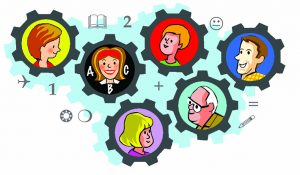Mal Lee and Roger Broadie
In undertaking your digital journey your mindset – and that of your school community – will gradually change and evolve, slowly but surely moving away from the traditional paper based, strongly analogue way of thinking, shifting to a far more digital and socially networked mindset.
The change – based on the experiences of the pathfinder schools – will likely be gradual and for a period one will default to the traditional ways but over time the digital mindset will become so natural as for you not to think about it, until you encounter those still operating in the analogue mode!
Examine the attributes at each of the key evolutionary stages (Lee and Broadie, 2016)) and you’ll note the pronounced change in thinking that occurs as the schools evolve and how by the Networked stage the school, the teachers and indeed the parents have adopted a very different mindset – a very different outlook and set of expectations to those at the Paper Based and Early Digital stages.
The digital mindset is in many respects antithetical to the analogue.
Bhaduri and Fischer in a 2015 Forbes business magazine asked ‘Are You a Digital or Analogue Leader? While directed at business leaders the two-page comparison of the distinguishing features of each type of leader remarkably parallels the change in thinking identified by the authors in the leaders in the pathfinder schools.
Download the comparison from – http://www.forbes.com/sites/billfischer/2015/03/19/are-you-an-analog-or-digital-leader/ – discuss it with your colleagues and position yourself.
By virtue of brevity the comparison verges on the black and white but critically it makes the point that it is the mindset of the CEO/the principal which strongly impacts the nature of the organisation and its culture.
Principals operating within a digital and networked mindset will run a very different kind of school to those ensconced within an insular analogue mindset.
Interestingly many of the pathfinder principals commented on their difficulty in explaining to traditional principals and teachers the nature of the schooling they were providing – so different were the two modes. Even in 2016 many school leaders can’t envision schools changing. They genuinely believe they know everything there is to know about schooling. In contrast the digital leaders are highly ambivalent about the form their schools will take in future years, even five years hence. While the former’s is a world of constancy and certainty the latter’s is world of rapid uncertain change and evolution where one forever on will be leading the school into uncharted waters.
What can you do to expedite the change in mindset in your school? We are not really sure.
Those associated with the pathfinder schools – and that includes the staff and the wider school community – have made the shift as part of the school’s evolution, it invariably taking years.
Logic would suggest the later adopter schools should learn from the early adopters and be able to hasten the change in thinking but the authors’ strong suspicion is that the deep-seated change in mindset will only come from the everyday association with evolving school ecosystems and cultures.
You’ll lose little by discussing the shift with your staff, by publicly noting significant shifts in thinking but bear mind historically you are talking about changing a mindset that has shaped schooling for hundreds of years. Moreover on your evolutionary journey you will need to change the thinking of all your staff, the students, the current and prospective families and indeed the wider school community while simultaneously addressing the plethora of other key variables.
That said the school will be operating integrally within an increasingly socially networked society, where most in the school’s community will have normalised the 24/7/365 use of the digital technology, will have rising expectations of the digital and where many of the parents will in their work be employing a digital and networked mindset
There is much to be said for being conscious of shifting the mindset but letting the continued evolution of the school and the societal pressures naturally do the job.
Bibliography
- Bhaduri, A and Fischer, B (2015) ‘Are You an Analogue or Digital Leader?’ Forbes 19/2/2015 – http://www.forbes.com/sites/billfischer/2015/03/19/are-you-an-analog-or-digital-leader/
- Lee, M and Broadie, R (2016) A Taxonomy of School Evolutionary Stages Broulee Australia http://www.schoolevolutionarystages.net

 Mal Lee and Roger Broadie
Mal Lee and Roger Broadie